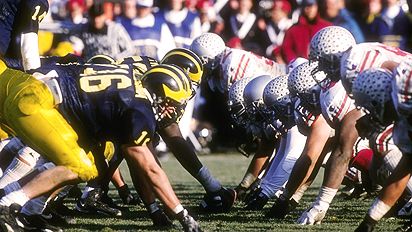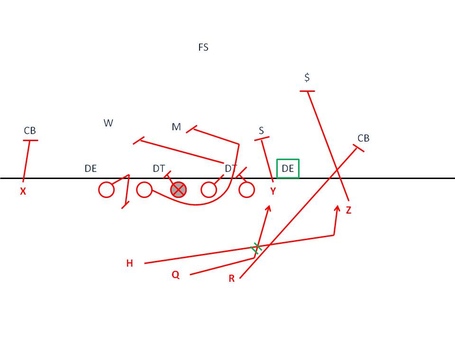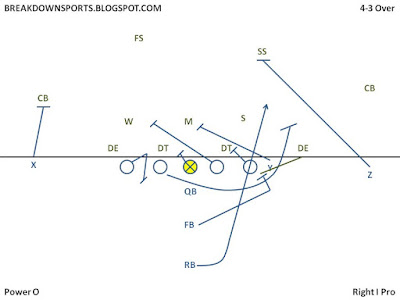Illinois didn’t have a lot of success against the Ohio State defense, but they did have a really nice run-pass option (RPO, aka package play) that they went to in order to take advantage of the Buckeye’s base Cover 4 defense.
The Setup
The Illini spent much of the day in trips split sets, which has its positives and negatives for the offense. This offense actually alleviates some of the quick hitting run pass options that plague many of the Cover 4 teams by not putting the safeties in as rapid of a run/pass option from the slot. But the Buckeyes play their safeties deeper than many Cover 4 defenses (such as Michigan State) which is their way of adapting to the spread, as it mitigates some of that run/pass conflict that the slot can attack by giving the safety more time read the play before reacting.
But a trips set doesn’t take the pressure off the defense. It still puts several players in difficult run pass conflicts, and it dictates the defense in such a way that it pulls defenders outside of the box to help in coverage support. Let’s take a look at how OSU typically plays trips sets.
Cover 4 Trips Adjustment
The Buckeyes typically adjust to trips with what is known as a “Solo” adjustment. The “solo” designation is because the isolated CB will no longer have over the top safety help, and instead will be matched up on an island with the lone split receiver. The safety initially lined up over the top of him instead will be responsible for covering the #3 WR on the opposite side of the field if he attacks vertically.
Run-Pass Option
One of the primary ways of defeating this coverage is to attack the defender that is left on an island. However, this is typically into the boundary and has underneath help from the LBs, so it must clear deep enough (meaning the offense must protect long enough) to allow the receiver to get down field; Illinois didn’t attack that proposition much. Instead, they went with a run-pass option.
The first read for the QB is a standard zone read of the DE. Lining up the RB toward the trips set allows both the first and second read to be in the same lane for the QB. If the DE stays home on the backside of the play, the QB gives to the RB on an inside zone run. If the DE crashes on the RB, he pulls the ball and takes his eyes to his second read: the flat defender (typically the OLB to that side against a Cover 4 scheme).
The flat defender is then forced to follow the bubble action from the #2 receiver or stay home to protect against the hitch. The hitch is being run about 7-9 yards, deep enough to get behind the LBs but in the gap between the 2nd and 3rd levels, but shallow/quick enough to not allow the safety from the opposite side of the field to play both the run and pass. He will settle down in the void in coverage.
If the flat defender bails outside (his shoulders are pointed to the sideline) the QB will look to the hitch. If his shoulders remain square or are turned inside, then he typically isn’t in a position to run down the bubble screen, and so the QB throws the bubble.
The outside receiver will essentially run a post, but he’s actually pulling the CB out of coverage and looking to block the safety, taking care of two defenders at once. This holds the safety aligned to the trips set and forces him to play deep (not allowing him to cheat up).
Examples
Here's the set up, 2nd and 10.
What you'll see after the snap is that Illinois is actually reading the MIKE, the ILB lined up over in the yellow box. He charges, so the QB pulls. Next he is reading the OLB, who you see turn and run with the bubble. You'll also note that the FS is retreating in coverage into a deep center while the SS stays in sort of a deep half coverage.
On the catch, it's actually the SS - who would help out the CB over the #1 in a longer progressing play - come down and make the tackle.
Here we are two plays later, after Illinois picks up a first down. Same formation, but flipped.
Immediately after the snap, see the MIKE charging at the run, and see how the OLB (Lee, has his shoulders turned inside. He's going to throw the bubble.
The ball carrier gets outside Lee and this turns into a 20+ yard gain.
The very next play, OSU comes out like this.
The QB makes a mistake and relies on his pre-snap read, which tells him the MIKE is in an apex, so he's out of the play. So he hands off. You'll note that the safety to the trips set has come down more to take away the quick throw, but the slant (which this route converts to) is still open over the middle of the field. This is a poor and impatient read by Lunt.
The Buckeyes clean up and get a TFL against the run with the extra LB. That adjustment with the MIKE is what we'll discuss next though.
OSU Adjusting Formation to Cover
There are several things that OSU can and does do. For one, their blitz package is typically a 3 under, 3 over or 2 under, 3 over coverage; or in summary, it’s a three-high defense, which differs from their standard Cover 4 and has a different rotation (thus changing where the QB must take his eyes). So teams can’t just be predictable with it.
Of course, there are also things in the Cover 4 scheme that they can do, such as running a trap coverage (allowing the CB to take any receiver that runs immediately to the flat, such as a bubble) that can mess with the QB’s reads.
As far as OSU is concerned, for the most part, they simply have superior players. Lee, the OLB typically tasked with playing that underneath zone, is a sort of safety/LB hybrid, in that he moves like a safety but hits like a LB. He is great at getting into his lane outside of the #2, so it is very difficult to get outside on him, even when he doesn’t immediately commit to the bubble. The rest of the defense, particularly the DBs, are athletic and mostly sound. That allows them to leave the boundary CB on an island.
But sometimes, even superior DBs aren’t enough to handle the coverage. In this game, after a few drives, OSU made an adjustment to their formation. They trusted a 5 man box to win against the 5 OL and split the MIKE into an apex position between the offensive EMOL and #3. With his read/run fit, he comes directly from the spot where the hitch tries to sit, meaning he’s sitting directly underneath where the offense wants to go. This forces the receiver to carry his route farther, allowing the far safety to react and get the coverage.
Did Illinois Adjust to This?
In fact, they did. When you split the MIKE out wide, you trust your front 5 to be able to win battles. But you also put pressure on your safeties to come up in run support on the interior. The safety to the trips set is still primarily a coverage defender, but the safety away from the trips set has more run pressure applied to him. That allows the offense to run something like this:
All this happened in the span of two drives midway through the third quarter, and it was very interesting to watch.
Conclusion
Illinois wasn’t really able to move the ball consistently on the Buckeyes, but a lot of that was the complete inability to move the ball on the ground. Through the air, they were able to have a little bit of success. Despite the outcome of the game, the chess match gives some good film for future opponents that are closer in skill to Ohio State. But at the end of the day, OSU is still very strong along their defense, and this just goes to show that even when the scheme is in your favor, good players and good execution can overcome some schematic weakness.










































